英语信息化教学设计教学案例设计
- 格式:doc
- 大小:53.00 KB
- 文档页数:6
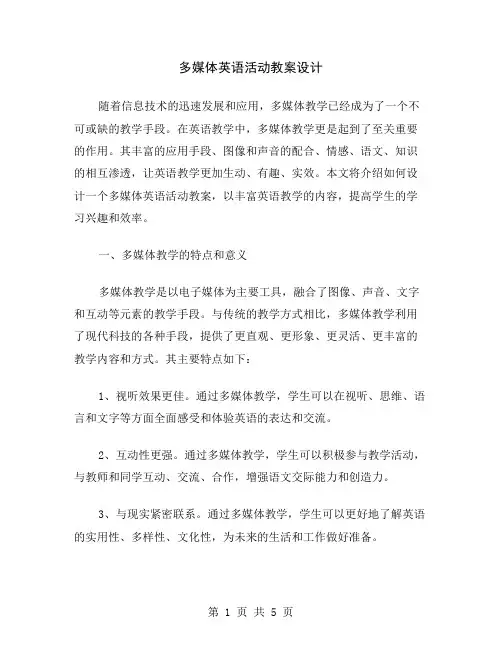
多媒体英语活动教案设计随着信息技术的迅速发展和应用,多媒体教学已经成为了一个不可或缺的教学手段。
在英语教学中,多媒体教学更是起到了至关重要的作用。
其丰富的应用手段、图像和声音的配合、情感、语文、知识的相互渗透,让英语教学更加生动、有趣、实效。
本文将介绍如何设计一个多媒体英语活动教案,以丰富英语教学的内容,提高学生的学习兴趣和效率。
一、多媒体教学的特点和意义多媒体教学是以电子媒体为主要工具,融合了图像、声音、文字和互动等元素的教学手段。
与传统的教学方式相比,多媒体教学利用了现代科技的各种手段,提供了更直观、更形象、更灵活、更丰富的教学内容和方式。
其主要特点如下:1、视听效果更佳。
通过多媒体教学,学生可以在视听、思维、语言和文字等方面全面感受和体验英语的表达和交流。
2、互动性更强。
通过多媒体教学,学生可以积极参与教学活动,与教师和同学互动、交流、合作,增强语文交际能力和创造力。
3、与现实紧密联系。
通过多媒体教学,学生可以更好地了解英语的实用性、多样性、文化性,为未来的生活和工作做好准备。
4、教学效果更好。
通过多媒体教学,学生可以更深入地理解课程内容,掌握更多的知识和技能,提高学习兴趣和学习效率。
二、多媒体英语活动教案设计根据多媒体教学的特点和意义,我们可以设计一个充分发挥多媒体教学优势的英语活动教案。
其设计过程如下:1、教学目标的确定在设计多媒体英语活动教案之前,我们首先需要确定教学目标。
教学目标应具有明确性、具体性和可操作性,以便教师和学生能够清晰地了解教学内容和要求,从而更好地完成教学任务。
例如,我们的教学目标可以如下所示:学生通过学习英语课文,掌握英语听、说、读、写的基本技能和语言知识;学生通过多媒体教学和活动实践,培养英语思维、阅读、写作和应用能力;学生能够准确地表达自己的想法和观点,与他人进行英语交流和合作。
2、教学内容的选择在确定了教学目标之后,我们需要选择合适的教学内容。
教学内容应具有生活化、情感化、文化化和创新化的特点,以激发学生的学习兴趣和潜力。
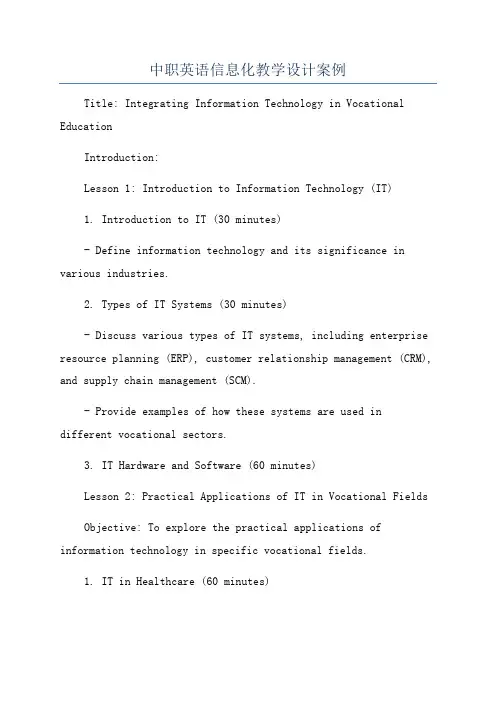
中职英语信息化教学设计案例Title: Integrating Information Technology in Vocational EducationIntroduction:Lesson 1: Introduction to Information Technology (IT)1. Introduction to IT (30 minutes)- Define information technology and its significance in various industries.2. Types of IT Systems (30 minutes)- Discuss various types of IT systems, including enterprise resource planning (ERP), customer relationship management (CRM), and supply chain management (SCM).- Provide examples of how these systems are used indifferent vocational sectors.3. IT Hardware and Software (60 minutes)Lesson 2: Practical Applications of IT in Vocational Fields Objective: To explore the practical applications of information technology in specific vocational fields.1. IT in Healthcare (60 minutes)- Discuss the use of electronic health records, telemedicine, and medical imaging systems.- Organize a virtual tour or guest lecture by professionals working in healthcare IT.2. IT in Manufacturing and Engineering (60 minutes)3. IT in Business and Marketing (60 minutes)Lesson 3: Ethical and Security Considerations in ITObjective: To address ethical and security issues related to information technology.1. Ethical Use of IT (30 minutes)- Discuss the importance of ethical behavior when using IT systems, including privacy, copyright laws, and responsible data usage.- Engage students in a class discussion about real-life ethical dilemmas related to information technology.2. IT Security (60 minutes)- Teach students how to protect themselves and their devices from cyber-attacks.3. IT and Cybersecurity Careers (30 minutes)- Introduce different career opportunities in the field of cybersecurity.- Invite a guest speaker who works in cybersecurity to share their experiences and provide career guidance.Conclusion:。
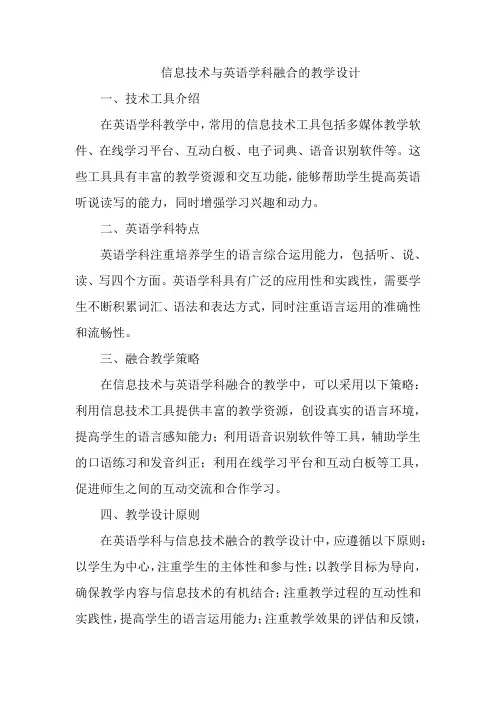
信息技术与英语学科融合的教学设计一、技术工具介绍在英语学科教学中,常用的信息技术工具包括多媒体教学软件、在线学习平台、互动白板、电子词典、语音识别软件等。
这些工具具有丰富的教学资源和交互功能,能够帮助学生提高英语听说读写的能力,同时增强学习兴趣和动力。
二、英语学科特点英语学科注重培养学生的语言综合运用能力,包括听、说、读、写四个方面。
英语学科具有广泛的应用性和实践性,需要学生不断积累词汇、语法和表达方式,同时注重语言运用的准确性和流畅性。
三、融合教学策略在信息技术与英语学科融合的教学中,可以采用以下策略:利用信息技术工具提供丰富的教学资源,创设真实的语言环境,提高学生的语言感知能力;利用语音识别软件等工具,辅助学生的口语练习和发音纠正;利用在线学习平台和互动白板等工具,促进师生之间的互动交流和合作学习。
四、教学设计原则在英语学科与信息技术融合的教学设计中,应遵循以下原则:以学生为中心,注重学生的主体性和参与性;以教学目标为导向,确保教学内容与信息技术的有机结合;注重教学过程的互动性和实践性,提高学生的语言运用能力;注重教学效果的评估和反馈,及时调整教学策略和方法。
五、教学实施步骤在英语学科与信息技术融合的教学实施中,可以按照以下步骤进行:明确教学目标和内容,选择合适的信息技术工具;设计教学活动和任务,注重学生的参与和互动;组织学生进行自主学习和合作学习,鼓励学生在实践中探索和创新;及时进行教学效果的评估和反馈,调整教学策略和方法。
六、教学效果评估对于信息技术与英语学科融合的教学效果评估,可以采用多种方式进行,如学生作品展示、课堂表现观察、在线测验、问卷调查等。
评估结果应能够反映学生在英语综合运用能力、信息素养、合作能力等方面的提升情况,同时也为教学改进提供依据。
七、教学资源推荐为了更好地支持信息技术与英语学科的融合教学,推荐以下教学资源:英语学科相关的多媒体教学软件、在线学习平台和资源库、语音识别和语音合成软件、互动白板和教学辅助工具等。
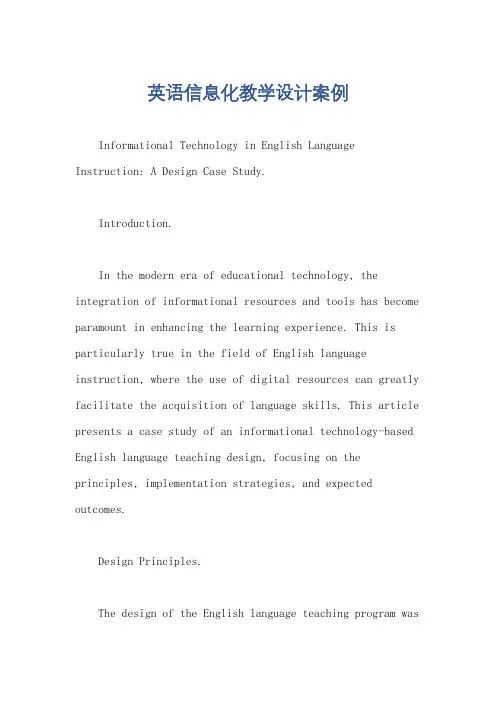
英语信息化教学设计案例Informational Technology in English Language Instruction: A Design Case Study.Introduction.In the modern era of educational technology, the integration of informational resources and tools has become paramount in enhancing the learning experience. This is particularly true in the field of English language instruction, where the use of digital resources can greatly facilitate the acquisition of language skills. This article presents a case study of an informational technology-based English language teaching design, focusing on the principles, implementation strategies, and expected outcomes.Design Principles.The design of the English language teaching program wasguided by several key principles:1. Student-Centered Learning: The program places the student at the center of the learning process, encouraging active participation and collaboration. Digital resources are used to create an interactive and engaging learning environment that caters to the diverse needs and interests of students.2. Blended Learning: The program combines traditional classroom instruction with online learning activities, leveraging the strengths of both approaches. This allows for a flexible and personalized learning experience that accommodates different learning styles and schedules.3. Authentic Language Use: The program emphasizes the use of authentic language materials and real-world scenarios to promote meaningful language use. This helps students develop the ability to communicate effectively in real-life contexts.4. Technology Integration: The program integrates arange of educational technologies, including interactive whiteboards, online learning platforms, and multimedia resources. These tools are used to enhance teaching and learning, making the content more accessible and engaging.Implementation Strategies.The following strategies were employed in the implementation of the English language teaching program:1. Curriculum Development: A comprehensive curriculum was developed that aligns with national education standards and incorporates informational technology resources. The curriculum covers a range of language skills, including reading, writing, speaking, and listening.2. Teacher Training: Teachers were provided with professional development opportunities to equip them with the necessary skills and knowledge to effectively integrate informational technology into their teaching practices. This included workshops on digital tools and resources, as well as strategies for promoting student engagement andcollaboration.3. Classroom Practices: In the classroom, teachers utilized digital resources to create interactive and engaging learning experiences. They employed a variety of teaching methods, such as collaborative projects, role-playing activities, and online discussions, to promoteactive learning and language use.4. Online Learning Platform: An online learningplatform was introduced to support blended learning. This platform provided students with access to digital materials, online assignments, and interactive exercises. It also allowed for teacher-student and student-student communication, facilitating collaboration and feedback.Expected Outcomes.The expected outcomes of the English language teaching program include:1. Improved Language Skills: Students will demonstrateimproved reading, writing, speaking, and listening skills through regular practice and exposure to authentic language materials.2. Enhanced Engagement and Motivation: The use of digital resources and interactive learning activities will foster a more engaging and motivating learning environment, increasing student participation and engagement.3. Development of Collaborative Skills: Collaborative projects and online discussions will promote teamwork and communication skills, preparing students for future academic and professional challenges.4. Preparedness for the Digital Age: By integrating informational technology into their learning experiences, students will be better prepared to navigate the digital age and utilize technology effectively in their academic and career pursuits.In conclusion, the integration of informational technology in English language instruction offerssignificant benefits to both teachers and students. By embracing a student-centered, blended learning approachthat leverages the power of digital resources and tools, we can create a more engaging, effective, and future-ready learning environment.。
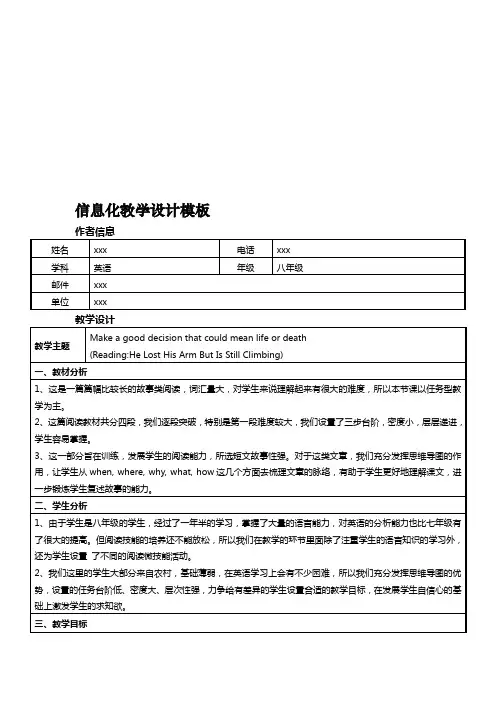
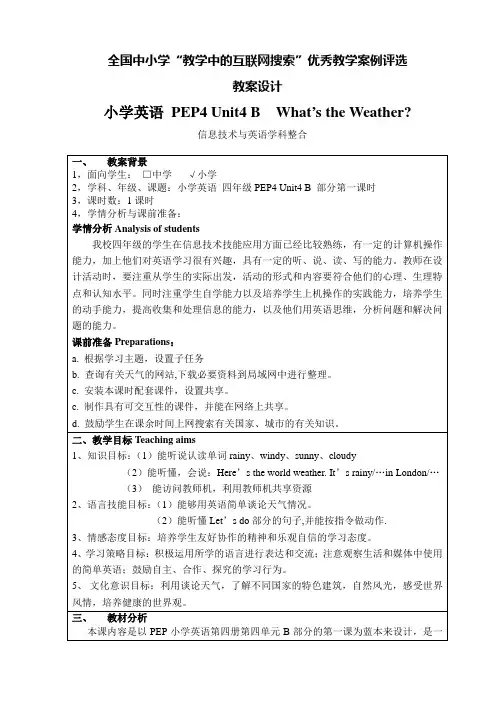
全国中小学“教学中的互联网搜索”优秀教学案例评选教案设计小学英语PEP4 Unit4 B What’s the Weather?信息技术与英语学科整合教学反思:本教学设计采用信息技术与英语学科整合的教学理念,并使用任务型活动方式,为学生提供了良好的英语学习环境和适当的资源,让学生在教学过程中自主学习,合作参与,并进行语言实践。
本课尝试运用信息技术于英语课堂教学中,通过设计What’s the Weather 这一课,我们有以下几点认识:1、注重生活化的教学设计,让学生参与体验,以学生为主体的活动安排。
一开始利用简笔画和利用百度搜索到的声音呈现生词,让学生初步体验和感受生词的含义,直观生动。
课堂设计以谈论天气What’s the weather?为主线,在一定的语境和情景中安排了多样的学生活动:从而培养学生用英语做事情和用英语进行交流的能力。
2、利用多媒体教学具有多样性、直观性和情境性的特点,它能有效地吸引学生的注意力,激发学生的学习兴趣和发挥学生主体的作用。
在本课教学中,通过计算机演示、交互等多种教学形式,让学生认识天气,各国天气文化知识等。
3.在现有教材内容再进行适当拓展。
教学大纲中只是要求学生在本课时里学会简单地描绘天气状况,但在设计中,我在完成课本内容的基础上再给学生进行适当的拓展,利用任务型活动,让学生在网络搜索当前各大城市的天气,复习已学词汇;让学生更深层次地学习如何在不同的天气下进行生活。
4、在语言教学中注意了文化意识的渗透。
教学中利用课件中向学生展示各个城市的著名的、或标志性的建筑,让学生在学习英语的过程中感受国外的风情,增长见识,将世界带入课堂。
5、信息技术与英语学科一次很好的整合。
本课不仅仅实现了信息技术与英语学科整合,还在在语言教学中融合自然学科的知识,体现了学科整合的思想。
6、独特的作业形式。
根据学生兴趣及认知特点,从学生的实际出发,向学生推荐相关。

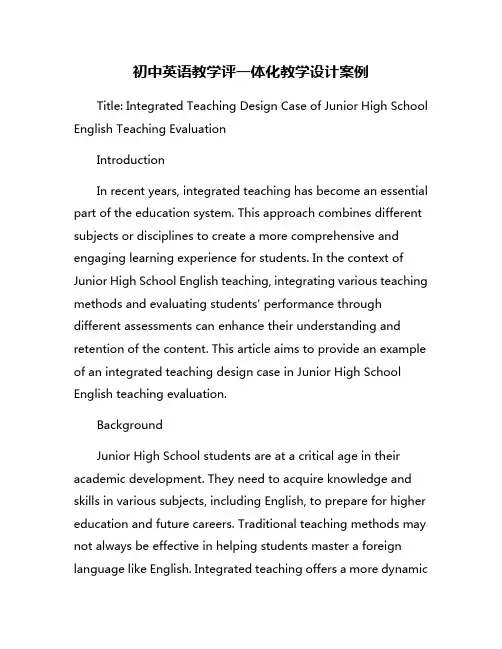
初中英语教学评一体化教学设计案例Title: Integrated Teaching Design Case of Junior High School English Teaching EvaluationIntroductionIn recent years, integrated teaching has become an essential part of the education system. This approach combines different subjects or disciplines to create a more comprehensive and engaging learning experience for students. In the context of Junior High School English teaching, integrating various teaching methods and evaluating students' performance through different assessments can enhance their understanding and retention of the content. This article aims to provide an example of an integrated teaching design case in Junior High School English teaching evaluation.BackgroundJunior High School students are at a critical age in their academic development. They need to acquire knowledge and skills in various subjects, including English, to prepare for higher education and future careers. Traditional teaching methods may not always be effective in helping students master a foreign language like English. Integrated teaching offers a more dynamicand interactive approach to learning, promoting critical thinking, creativity, and collaboration among students.Case StudyIn this case study, we will explore an integrated teaching design for evaluating students' English proficiency in a Junior High School setting. The lesson plan will incorporate different teaching methods, assessment tools, and activities to engage students and improve their language skills.Lesson Objective:- To assess students' listening, speaking, reading, and writing skills in English- To promote collaborative learning and critical thinking among students- To provide meaningful feedback on students' performanceIntegrated Teaching Design:1. Warm-up Activity:- Students will watch a short video clip in English and discuss it in groups. This activity will help students activate their prior knowledge and improve their listening and speaking skills.2. Reading Comprehension Task:- Students will read a passage in English and answer comprehension questions individually. This task will assess students' reading skills and understanding of the text.3. Group Discussion:- Students will work in groups to discuss a given topic in English. They will take turns speaking and listening to each other, improving their speaking and listening skills.4. Writing Task:- Students will write a short paragraph on the given topic. This task will assess students' writing skills and grammar proficiency.5. Peer Evaluation:- After completing the writing task, students will exchange papers with their peers and provide feedback on each other's work. This activity will promote collaborative learning and critical thinking.6. Teacher Evaluation:- Finally, the teacher will evaluate students' overall performance based on the assessment tasks and provideconstructive feedback to help students improve their English proficiency.Assessment Tools:- Rubrics: Rubrics will be used to evaluate students' performance in each task based on specific criteria, such as content, language accuracy, fluency, and coherence.- Self-assessment: Students will assess their own performance in each task and reflect on their strengths and areas for improvement. This self-assessment will help students become more aware of their learning progress and take ownership of their learning.- Peer assessment: Students will assess their peers' performance in the writing task and provide feedback on each other's work. This peer evaluation will encourage students to collaborate, communicate effectively, and develop critical thinking skills.ConclusionThis integrated teaching design case demonstrates how Junior High School English teaching evaluation can be enhanced through a variety of teaching methods and assessment tools. By combining different activities, assessments, and feedbackmechanisms, teachers can create a more engaging and effective learning environment for students. Integrated teaching not only improves students' English proficiency but also promotes critical thinking, collaboration, and self-reflection. It is essential for teachers to continue exploring innovative approaches to teaching evaluation to meet the diverse needs of Junior High School students and prepare them for success in their academic and professional lives.。
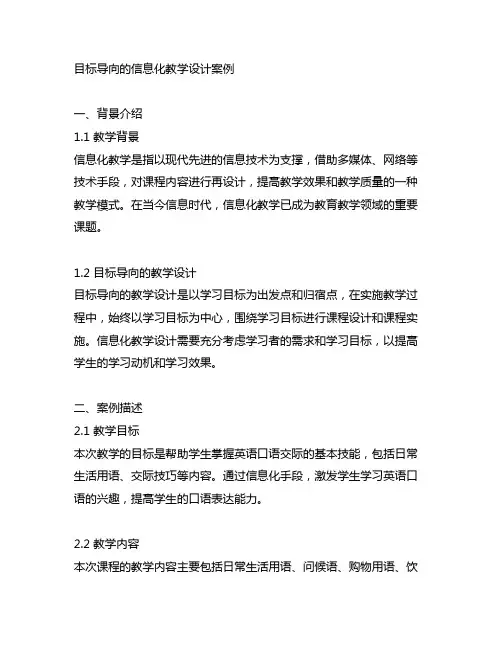
目标导向的信息化教学设计案例一、背景介绍1.1 教学背景信息化教学是指以现代先进的信息技术为支撑,借助多媒体、网络等技术手段,对课程内容进行再设计,提高教学效果和教学质量的一种教学模式。
在当今信息时代,信息化教学已成为教育教学领域的重要课题。
1.2 目标导向的教学设计目标导向的教学设计是以学习目标为出发点和归宿点,在实施教学过程中,始终以学习目标为中心,围绕学习目标进行课程设计和课程实施。
信息化教学设计需要充分考虑学习者的需求和学习目标,以提高学生的学习动机和学习效果。
二、案例描述2.1 教学目标本次教学的目标是帮助学生掌握英语口语交际的基本技能,包括日常生活用语、交际技巧等内容。
通过信息化手段,激发学生学习英语口语的兴趣,提高学生的口语表达能力。
2.2 教学内容本次课程的教学内容主要包括日常生活用语、问候语、购物用语、饮食用语等实用的口语表达内容。
教学内容以实用性和能够激发学生兴趣为主要考量。
2.3 教学方法在信息化教学设计中,利用多媒体技术和网络资源,设计了丰富多彩的教学活动,包括口语对话练习、角色扮演、小组讨论等形式,激发学生的学习兴趣,提高课堂活跃度。
2.4 教学资源本次教学利用了多媒体教学课件、网络资源和教学设备等信息化资源,丰富了教学手段和教学内容,提高了教学效果。
2.5 教学评价教学过程中设置了多种评价手段,包括课堂练习的评价、课后作业的评价、小组讨论的评价等,充分全面地评价了学生的口语表达能力和交际技巧。
三、教学效果分析3.1 学习动机的提高信息化教学设计使得教学内容更加生动有趣,激发了学生学习英语口语的兴趣,提高了学生学习的主动性和积极性。
3.2 学习效果的提升通过信息化手段,教师能够更好地展现教学内容,让学生容易理解和接受教学内容,提高了学习效果;学生在多媒体和网络资源的帮助下,能够更好地掌握口语表达技巧。
3.3 教学质量的提高目标导向的信息化教学设计使得教学内容更加贴近学生的需求,更加注重学生的学习效果和能力的提升,能够更好地提高了教学质量。
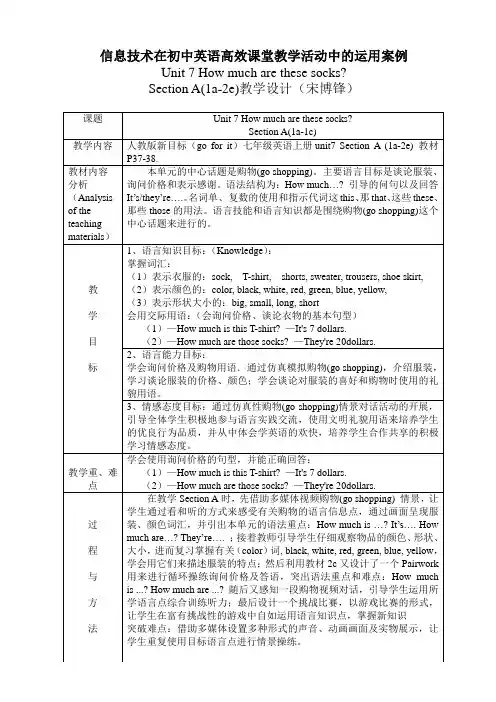
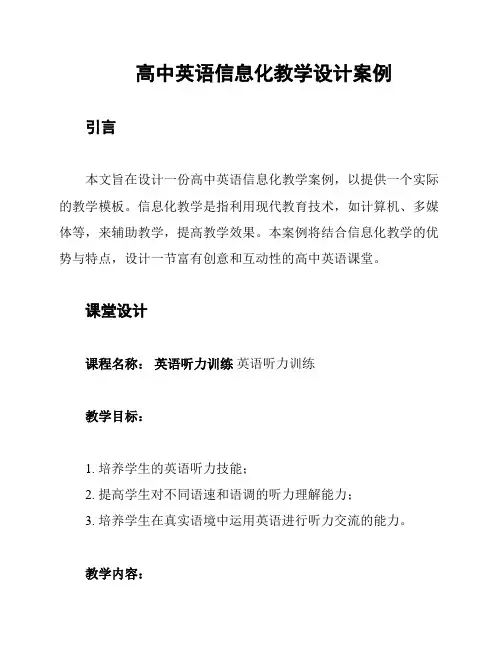
高中英语信息化教学设计案例引言本文旨在设计一份高中英语信息化教学案例,以提供一个实际的教学模板。
信息化教学是指利用现代教育技术,如计算机、多媒体等,来辅助教学,提高教学效果。
本案例将结合信息化教学的优势与特点,设计一节富有创意和互动性的高中英语课堂。
课堂设计课程名称:英语听力训练英语听力训练教学目标:1. 培养学生的英语听力技能;2. 提高学生对不同语速和语调的听力理解能力;3. 培养学生在真实语境中运用英语进行听力交流的能力。
教学内容:1. 听力原文:一段关于如何健康饮食的英语短文;2. 听力练:针对短文内容安排多个听力练题,包括听取关键信息、理解说话者意图等。
教学步骤:1. 引入:通过展示一张健康饮食的图片,引起学生对话题的兴趣;2. 信息化演示:播放视频,展示一段关于健康饮食的视频,引导学生对话题的讨论;3. 听力原文讲解:给出关于健康饮食的英语短文原文,通过教师的讲解和问答互动,帮助学生理解原文内容;4. 听力练:安排多个听力练题,如填空、选择题等,帮助学生巩固听力技能;5. 听力讨论:引导学生就听力练题进行讨论,提高他们理解说话者意图的能力;6. 反馈与总结:教师给予学生听力练的反馈与评价,并总结本节课的研究成果。
信息化教学活动策略1. 利用多媒体资源:通过播放视频、展示图片等多媒体资源,丰富教学内容,激发学生兴趣;2. 提供个性化研究:根据学生的不同水平和需求,提供个性化的听力练题,帮助他们更好地掌握听力技巧;3. 引导学生互动与讨论:通过教师的引导和组织,鼓励学生与同学一起进行听力讨论,提高他们的交流能力和合作意识;4. 及时反馈与评价:教师在课堂上对学生的听力练进行及时反馈和评价,帮助他们发现问题并改进。
总结本教学设计案例充分利用信息化技术的优势,通过多媒体资源和个性化研究策略,提高了教学的创意和互动性。
通过这样的信息化教学方式,学生能够更好地培养英语听力技能,并在真实语境中灵活运用所学知识。
信息化英语教学设计案例范文Alright, here's a sample of an informal and conversational English language teaching design focused on integrating technology into the classroom:Okay, guys, let's talk about how we can make English learning more fun and interactive with technology! First off, why don't we try using video clips from popular movies or TV shows? You know, those scenes where the characters are having an intense conversation? We can pause it at key moments and discuss the language used. That's a great way to practice listening comprehension and vocabulary.Another cool idea is to utilize online platforms that allow us to create our own virtual classrooms. With these tools, we can hold live discussions, role-play scenarios, or even host debates in English. It's like having a real-life conversation, but with the added bonus of being able to rewind and review anything you didn't quite catch.Oh, and don't forget about mobile apps! There are so many out there that are specifically designed to help with language learning. Some of them even have games and quizzes that make learning feel more like playing. Plus, you can access them anytime, anywhere, so you can squeeze in a bit of learning during your free time.But it's not just about apps and videos. We can also incorporate technology into our traditional classroom activities. Think about using digital projectors to show interactive presentations or using tablets for group work. Even simple tools like a whiteboard app can make a huge difference in engaging students.And finally, let's not forget.。
2024河大教材,六年级下册信息科学教学案例英文版Title: Information Science Teaching Case Study for Grade 6, 2024 River University Textbook, Second SemesterIn the 2024 River University Grade 6 textbook for Information Science, there are various case studies that provide practical examples for students to apply their knowledge. These case studies cover a range of topics such as computer programming, data analysis, and internet safety.One case study focuses on teaching students how to code using Scratch, a visual programming language. Students are tasked with creating a simple game or animation using Scratch, which helps them understand the basics of coding and computational thinking.Another case study delves into data analysis, where students are given a set of data and are asked to analyze and interpret it usingspreadsheets. This case study helps students develop their analytical skills and understand the importance of data in making informed decisions.Furthermore, there is a case study on internet safety, where students learn about the potential risks of sharing personal information online and how to protect themselves from online threats. This case study emphasizes the importance of digital literacy and responsible online behavior.Overall, the information science teaching case studies in the Grade 6 textbook provide practical and engaging activities for students to apply their knowledge and skills in real-world scenarios. These case studies help students develop critical thinking, problem-solving, and digital literacy skills, preparing them for the digital age.。
高中信息学科英语教案教学目标:1. 学生能够理解和掌握信息科学相关的基本英语词汇和表达方式。
2. 学生能够通过英语阅读材料,了解信息科学的基础知识和应用。
3. 学生能够在英语环境下讨论和分享信息科学相关的话题。
4. 学生能够撰写简单的信息科学英文报告或论文。
教学内容:1. 信息科学基础词汇与概念介绍。
2. 信息技术的历史与发展。
3. 计算机硬件与软件基础知识。
4. 互联网的原理与应用。
5. 信息安全的重要性及保护措施。
6. 人工智能的初步了解。
教学方法:1. 采用多媒体教学,结合T、视频等辅助教学工具。
2. 小组合作学习,鼓励学生之间的互动和讨论。
3. 实践操作,如编程练习、网络搜索等,以增强学生的实际操作能力。
4. 开展主题演讲和辩论,提高学生的语言表达能力。
教学步骤:1. 导入新课:通过提问或展示相关图片,激发学生对信息科学的兴趣。
2. 词汇与概念讲解:系统介绍本节课的关键词汇和概念。
3. 阅读理解:提供英文阅读材料,让学生了解信息科学的基础知识。
4. 小组讨论:学生分组讨论阅读材料中的问题或主题。
5. 实践操作:指导学生进行相关的计算机操作或网络搜索练习。
6. 总结反馈:教师总结本节课的重点内容,并对学生的表现给予反馈。
7. 作业布置:根据课堂内容,布置相应的英语书面作业。
评价方式:1. 平时表现:包括课堂参与度、小组讨论贡献等。
2. 作业完成情况:检查学生的书面作业,评估其理解和运用能力。
3. 测试与考核:定期进行小测验或期末考试,检验学生的学习成果。
英语信息化教学设计一、引言陶行知先生有次在武汉大学讲演,竟从皮包里拿出一只大公鸡,在众人诧异的目光中,他按住公鸡的头,强逼它吃他放在桌上的一把米,可公鸡只叫不吃。
然后他松开手,自己后退了几步,这时候公鸡自己吃起米来。
接着陶先生开始讲演:“我认为,教育就跟喂鸡一样!先生强迫学生去学习,把知识硬灌给他,他是不情愿学的,即使学,也是食而不化,过不了多久,他还会把知识还给先生的。
但是,如果让他自由地学习,充发挥他的主观能动性,那效果一定会好得多!”二、背景信息技术是指人类对数据、语言、文字、声音、图画和影像等各种信息进行采集、处理、存储、传输和检索的经验、知识及其手段、工具的总和。
它的核心技术是3C(computer,communication,contents)。
信息技术与课程教育教学的整合是教育部面向新世纪所制定的英语新课程标准大力提倡的:“在开发英语课程资源时,要充分利用信息技术和互联网”。
“整合”是为了更好地实现信息技术教育和英语教学的目标———培养学生获取、加工和利用信息的能力,以人为本,培养学生的综合语言运用能力。
以计算机技术和网络通讯技术为主要标志的信息技术,对当今社会产生重大影响,使教育思想、观念、模式等发生了巨大变化。
信息技术与学科教学的整合(IntegratingInformationTechnologyintotheCurriculum-IITC),已成为基础教育教学改革的新视点。
如何在高中英语教学中利用电脑和网络技术,改善高中英语教学模式,有效地实现信息技术与英语学科的整合成为广大教育工作者与一线教师共同关注与研究的热点问题。
四、整合教学案例介绍与分析本节课主要目标通过WarmingupandSpeaking(热身及口语)的学习达到以下目标:1.\n用新旧知识解决问题,完成任务。
在此基础上鼓励学生大胆地根据各自的语言基础与能力,有个性地解决问题,就如何有效地节约水、保护水提出独特的见解。
英文信息化处理教学设计模板范文English:In designing a teaching template for information technology processing, it is essential to incorporate a blend of theoretical knowledge and practical application. The curriculum should start with an introduction to fundamental concepts such as data types, data structures, algorithms, and programming languages. This foundational knowledge will provide students with a solid understanding of the principles behind information processing. The teaching approach should then transition into hands-on practice, allowing students to apply their theoretical knowledge to real-world scenarios. Through practical exercises and projects, students can develop problem-solving skills and gain valuable experience in utilizing various software tools for information processing. Additionally, the curriculum should include case studies and examples from industry best practices to help students understand the relevance and importance of information technology processing in different sectors. By providing a comprehensive and well-rounded educational experience that combines theory, practice, and real-world applications, students will be better equipped to succeed inthe field of information technology processing.Chinese:在设计信息化处理教学模板时,必须结合理论知识和实际应用。
初中英语信息化教学案例或教学设计Here is an essay on the topic of "Case Study or Teaching Design of Informatization of English Teaching in Middle School", with a word count greater than 1000 words, written in English without any additional punctuation marks in the body of the text.The integration of information technology into the teaching of English in middle schools has become an increasingly important trend in recent years. This approach, known as the informatization of English teaching, has the potential to revolutionize the way students learn and engage with the language. By incorporating digital tools and resources into the classroom, teachers can create dynamic and interactive learning environments that cater to the diverse needs and learning styles of their students.One successful case study of informatization in middle school English teaching can be found in a school located in a suburban area. The school recognized the importance of incorporating technology into their curriculum and made a concerted effort to invest in the necessary infrastructure and training for their teachers. The result was a comprehensive program that transformed the way English was taught and learned in the classroom.At the heart of this program was the integration of interactive whiteboards and multimedia projectors into every English classroom. These tools allowed teachers to seamlessly incorporate a wide range of digital resources into their lessons, including videos, audio recordings, and interactive exercises. This not only made the lessons more engaging and dynamic but also enabled teachers to differentiate their instruction to better meet the needs of individual students.For example, in a unit on reading comprehension, the teacher might use the interactive whiteboard to display a text passage and then guide students through a series of interactive activities designed to test their understanding. These activities might include multiple-choice questions, drag-and-drop exercises, or even virtual discussions where students could annotate the text and share their thoughts with the class.Similarly, in a grammar lesson, the teacher might use multimedia presentations to illustrate complex grammatical concepts, and then provide students with opportunities to practice their skills through interactive exercises and games. This approach not only helped students to better understand and retain the material but also made the learning process more enjoyable and engaging.Another key component of the informatization program was the integration of online learning platforms and resources. The school invested in a learning management system that allowed teachers to create and assign digital assignments, provide feedback and support to students, and track their progress over time. This system also gave students access to a wealth of online resources, such as language learning apps, virtual tutors, and multimedia content, which they could use to supplement their in-class learning.One particularly successful example of this was the school's implementation of a flipped classroom model for certain English units. In this approach, students would watch pre-recorded video lessons at home, and then use class time to engage in collaborative activities and discussions that reinforced the concepts they had learned. This not only freed up valuable class time for more interactive and engaging learning experiences but also allowed students to learn at their own pace and revisit the material as needed.The impact of this informatization program on student learning outcomes was significant. Standardized test scores in English improved across the board, with particularly notable gains among students who had historically struggled with the subject. Additionally, student engagement and enthusiasm for English class increased dramatically, as evidenced by higher attendance rates and more active participation in classroom activities.Perhaps most importantly, the program helped to foster a greater sense of digital literacy and technological competence among the students. By regularly using digital tools and resources in their English classes, students developed the skills and confidence to navigate the increasingly technology-driven world around them. This has proven to be an invaluable asset as they continue their educational and career journeys.The success of this informatization program in middle school English teaching serves as a powerful example of the transformative potential of technology in education. By leveraging digital tools and resources, teachers can create dynamic and engaging learning environments that cater to the diverse needs and learning styles of their students. Moreover, the integration of technology into the classroom can help to develop essential digital literacy skills that will serve students well in the years to come.As the demand for technology-driven education continues to grow, it is clear that the informatization of English teaching in middle schools will only become more important. By embracing this approach and investing in the necessary infrastructure and training, schools can position their students for success in an increasingly digital world.。